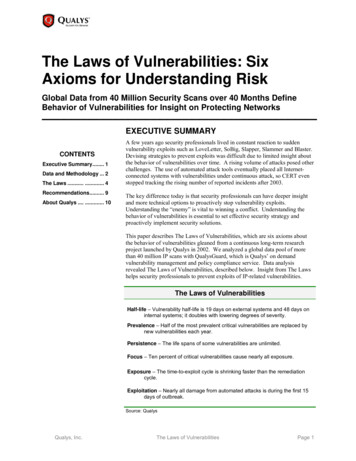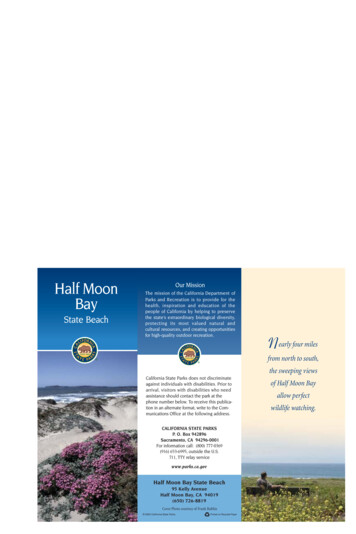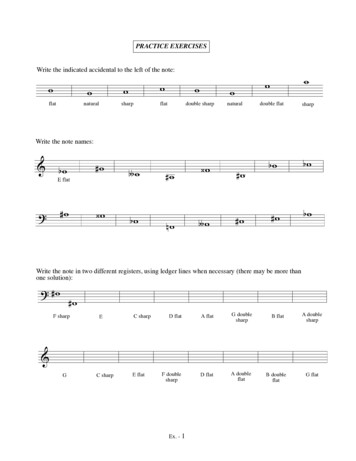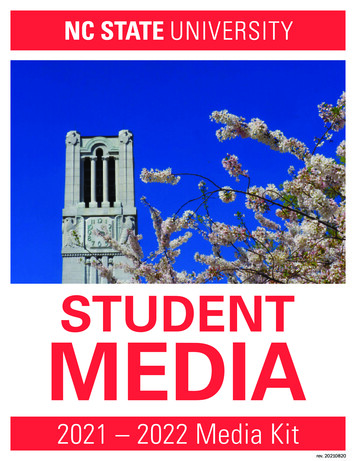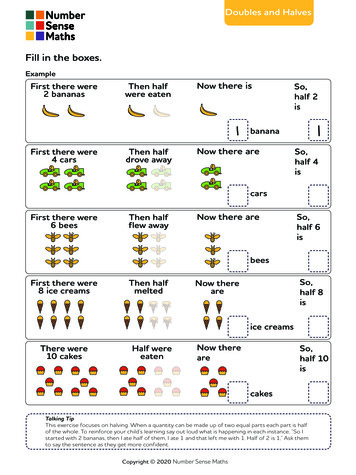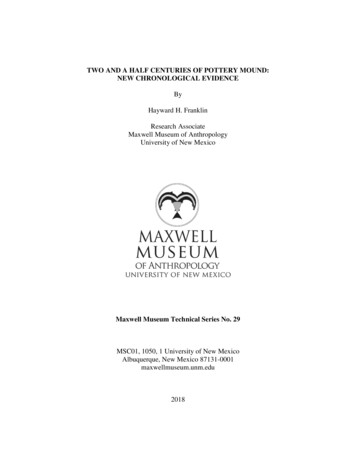
Transcription
TWO AND A HALF CENTURIES OF POTTERY MOUND:NEW CHRONOLOGICAL EVIDENCEByHayward H. FranklinResearch AssociateMaxwell Museum of AnthropologyUniversity of New MexicoMaxwell Museum Technical Series No. 29MSC01, 1050, 1 University of New MexicoAlbuquerque, New Mexico 87131-0001maxwellmuseum.unm.edu2018
Copyright 2018, Maxwell Museum of AnthropologyUniversity of New Mexico
TABLE OF CONTENTSPageList of Figures. ivList of Tables. viPreface and Acknowledgments.vii1. INTRODUCTION. 1The Significance of Pottery Mound. 12. THE RESEARCH CONTEXT. 3Rio Grande Glaze Ware. 4Previous Archaeological Studies. 83. INTRODUCTION TO THE ANNEX. 174. CERAMIC ANALYSIS.21Methods.21Type Frequencies. 21Rio Grande Glaze Ware. 23Painted Non-Glaze and Trade Sherds. 25Utility Ware. 26Vessel Forms.26Painted Vessels. 26Utility Vessels. 28Sources of Temper. 28Temper Frequencies. 29Paste Clays. 32Discussion. 325. RADIOCARBON DATES. 356. DISCUSSION AND CONCLUSIONS. 37Continuity and Change at Pottery Mound. 37Pottery Mound as a Contact Period Site. 38Pottery Mound in Time and Space.39REFERENCES CITED. 41APPENDIX A. H. P. Mera’s Pottery Mound Surface Collection, by David H. Snow. 49APPENDIX B. Photographs of Potsherds from the Annex at Pottery Mound. 51iii
TABLE OF CONTENTS, continuedPageAPPENDIX C. Photographs of Pottery Tempers and Rocks. 69APPENDIX D. Radiocarbon Dates from the Annex. 77FIGURES1. Mera’s proposed glaze ware rim sequence. 52. McKenna and Miles’ rim profile chart for Rio Grande Glaze Ware. 63. Percentages of glaze ware rim forms by decorative type. 134. Aerial view of Pottery Mound. 155. The Annex, looking toward Hidden Mountain. 186. Erosion at the edge of the Annex. 187. A map that may show part of the Annex. 198. Sherds in an erosional exposure near Marshall’s Profile 9. 209. Glaze ware rim profiles at Pottery Mound and the Annex. 2410. Munsell colors of sherds refired in an oxidizing atmosphere. 33B.1. Glaze A bowl rims (interior views). 51B.2. San Clemente Glaze Polychrome bowl rims (interior views). 51B.3. Additional San Clemente Glaze Polychrome bowl rims (interior views). 52B.4. Pottery Mound Glaze Polychrome bowl interior, “Hopi” style. 52B.5. Pottery Mound Glaze Polychrome jar fragment. 53B.6. Pottery Mound Glaze Polychrome jar sherd. 53B.7. Pottery Mound Glaze Polychrome bowl rim.54B.8. Glaze C rims (interior views). Left: Espinoso Glaze Polychrome. Right: Kuaua GlazePolychrome. 54B.9. Glaze C rims (exterior views). Left; Espinoso Glaze Polychrome. Right: Kuaua GlazePolychrome. 55B.10. Three Glaze C, Kuaua Glaze Polychrome bowl rims (exterior views). 55B.11. Three Glaze C, Kuaua Glaze Polychrome bowl rims (interior views).56B.12. Kuaua Glaze Polychrome bowl rims with exterior decorations (exterior views). 56B.13. Kuaua Glaze Polychrome bowl rims with exterior decorations (interior views). 57B.14. Kuaua Glaze Polychrome bowl rim, yellow slip (exterior view). 57B.15. Kuaua Glaze Polychrome bowl rim, yellow slip (interior view). 58B.16. Glaze D, San Lazaro Glaze Polychrome bowl rims (interior views). 58B.17. Glaze D, San Lazaro Glaze Polychrome bowl rims (exterior views). 59B.18. Glaze D carinated shoulder. 59B.19. San Lazaro Glaze Polychrome bowl rim (interior view). 60B.20. San Lazaro Glaze Polychrome bowl rim (exterior view). 60iv
FIGURES, continuedPageB.21. Glaze E, Puaray Glaze Polychrome, bowl rims (interior views). 61B.22. Glaze E, Puaray Glaze Polychrome, bowl rims (exterior views). 61B.23. Glaze E bowl rim (exterior view). 62B.24. Glaze E bowl rim with bubbly glaze (exterior view). 62B.25. Glaze E bowl rim with unusual decoration (exterior view). 63B.26. Glaze E bowl rim with unusual decoration (interior view). 63B.27. Hopi area yellow ware: Jeddito and Sikyatki sherds.64B.28. Wingate Black-on-red bowl sherd.64B.29. Pinnawa Glaze-on-white bowl rim (interior view). 65B.30. Pinnawa Glaze-on-white bowl rim (exterior view). 65B.31. Kechipawan Polychrome bowl (interior view). 66B.32. Interior handle in jar. 66B.33. Sherd of exposed-coil bowl (exterior view). 67B.34. Polychrome worked sherd (gaming piece). 67B.35. Corrugated utility jar sherd (exterior view).68B.36. Micaceous plain utility jar rim (interior view). 68C.1. Socorro Black-on-white, showing white paste and sherd temper. 69C.2. Kechipawan Polychrome, showing white paste and sherd temper. 69C.3. Glaze D, showing dark basalt temper. 70C.4. Rio Grande plain gray utility ware, showing black basalt temper. 70C.5. Rio Grande plain gray utility ware, showing black basalt temper. 71C.6. Rio Grande plain gray utility ware, showing black basalt temper. 71C.7. Rio Grande plain gray utility ware, showing red basalt temper. 72C.8. Glaze D, showing red and black basalt temper. 72C.9. Rio Grande plain gray utility ware, showing sandstone temper. 73C.10. Glaze polychrome showing sandstone temper. 73C.11. Rio Grande plain gray ware, showing sandstone temper. 74C.12. Glaze D, showing sandstone temper. 74C.13. Red vesicular basalt sample from Annex. 75C.14. Basalt rock sample from Annex. 75C.15. Sandstone sample from Annex. 76C.16. Red vesicular basalt and dark diabase basalt from Annex./. 76v
TABLES1. Dates for Pottery Types of the Middle Rio Grande Region.72. Dates for Imported Pottery Types. 133. The Sherd Assemblage from the Annex. 224. The Annex: Pottery Types by Vessel Form. 275. The Annex: Pottery Types by Temper. 30vi
PREFACE AND ACKNOWLEDGMENTSUnder the direction of Isleta Pueblo Cultural and Historic Preservation Department, PotteryMound is undergoing new interdisciplinary scientific research as well as stabilization. Thecurrent examination of the site’s stratigraphic and depositional history will undoubtedly revealnew details of the depth of the ceramic history of Pottery Mound. Another goal of the ongoinginvestigations is to obtain more radiocarbon dates from the site. Michael Marshall and hiscolleagues already have gathered a considerable amount of new data that will provide a moreaccurate picture of an extraordinary community, which was a center of commerce and a true artcolony.I sincerely appreciate the Pueblo of Isleta’s encouragement of continuing research at PotteryMound and the opportunity provided by the Pueblo to continue the Annex ceramic analysisdescribed in this report. Isleta’s Historic Preservation Department (Daniel Waseta, Director, andHenry Walt, Tribal Historic Preservation Officer) and archaeologists Michael Marshall andMichael Bletzer are to be commended for their continuing efforts to preserve and interpret thisimportant site. I especially value the longstanding friendship, encouragement, and archaeologicalexpertise of my colleague Michael Marshall. Our collaboration both in the field and the lab hasbeen interesting and productive. Thanks also to the Maxwell Museum of Anthropology,University of New Mexico. The Museum’s stewardship of Pottery Mound over a number ofyears—an effort led by Dave Phillips, then the curator of archaeology—contributed to itspreservation and interpretation. My association with Dave, during many trips to the site for sitemapping and monitoring, has been very rewarding. His service as editor of the museum’sTechnical Series has resulted in more than 30 papers by a variety of authors, all available online.Thanks also to Diane Tyink and Karen Price of the Maxwell Museum staff. I also owe thanks tomany individuals whose archaeological contributions and friendship are greatly appreciated,among them Karen Armstrong, Jean Ballagh, Steve Rospopo, Kari Schleher, Lou Schuyler, andDavid Snow.vii
viii
Chapter 1INTRODUCTIONPottery Mound (LA 416), west of Los Lunas, New Mexico, is one of the best known and moststudied prehistoric Pueblo ruins of the Middle Rio Grande Region. Occupied during the ClassicPeriod, the site began about A.D. 1300 or slightly later and lasted until at least 1550 (all datesherein are A.D.). This is not the date range usually assigned to the site; based on the dominantdecorated ceramics, plus a few dates, in years past Pottery Mound was assigned only to the GlazeA horizon—about 1350 to 1450. The near-lack of absolute dates combined with amisunderstanding of the local pottery sequence to contribute to the chronological confusion. Thisreport applies new ceramic and other dating evidence to show that the occupation of PotteryMound lasted much longer than many believed.My collaboration with Michael Marshall of the Isleta Pueblo Historic Preservation Division andDavid Phillips of the Maxwell Museum of Anthropology, University of New Mexico, has beenmost valuable in this project. Research at the site continues and will certainly reveal additionalinsights; the data in this paper are current as of November 2017.The Significance of Pottery MoundRenown for its striking kiva murals and finely made ceramics, Pottery Mound sits on the banksof the Rio Puerco of central New Mexico. This paper focuses on the ceramics, which have beenextensively studied because of the variety of pottery types, their artistic quality, and evidence ofextensive long-distance exchange.A visitor to the site today might be puzzled about its notoriety, however. The first impression isof eroding low mounds perched on a rapidly eroding bluff, about 10 m above the incisedfloodplain of the Rio Puerco. The present mounds are partly melted adobe, but also backdirt—including from the misuse of heavy equipment in past. It is difficult to be aware of the site’smany kivas and other rooms, possibly five hundred in all, and an unknown number of them havewashed away over the centuries.Most large Classic Period pueblos of the region were built along the Rio Grande (Marshall andWalt 1984); Pottery Mound is removed from the main cluster of villages, in what seems like anodd place for an important village. It was nevertheless strategically positioned between the RioGrande pueblos to the east and the prehistoric centers of the Acoma-Zuni district to the west.Even farther west along this axis of travel were the Hopi mesas and contemporary large villagesof the middle Little Colorado River. Pottery Mound’s populace was in a prime location to sendand receive many kinds of trade goods among the Pueblos. Furthermore, as a nexus for travel incentral New Mexico, Pottery Mound must have received many visitors from distant towns. Wecan imagine a diverse population of permanent and temporary residents speaking Keres, Tiwa,Piro, Zuni, and Hopi dialects.1
Excavation of portions of the site, over many years, revealed the existence of several major roomblocks and different styles of kivas. Many of the kiva walls were repeatedly plastered andcarefully painted, depicted ritual scenes and elaborate textile designs. While the murals becamethe focus of Frank Hibben’s work at the site (Hibben 1975), Pottery Mound was noteworthy forother reasons. Goods from distant places included pottery, marine shell jewelry, at least onecopper bell, and possibly a macaw.Pottery Mound was a center of pottery production during Classic period, matching the creativityof the better-known murals. The local potters produced some of the finest wares in theprehistoric Southwest. Michael Marshall likes to describe Pottery Mound was an “art colony,”reflecting the artistic creativity expressed at the site. Whatever its exact role, Pottery Mound wasnot an ordinary late prehistoric Pueblo village.2
Chapter 2THE RESEARCH CONTEXTIn the Southwest as elsewhere, using ceramics to make inference about time and space requiresaccurate identification of samples according to standard classification systems. Building on ahundred years or so years of effort, regional pottery “types” are based on consistent uses of clays,tempers, surface decorations, and firing techniques. This approach has yielded an excellentunderstanding of the technical and stylistic variations typical of given areas and periods. Anotherfrequently used classificatory concept, “ware” (a group of types, usually sharing a basicmanufacturing approach), represents larger slices of time and often larger areas of origin, andpresumably multiple communities of potters. Less frequently, “varieties” are defined withintypes, usually on minor stylistic or technological variations; presumably, that variation occurredat the village level or lower and represented the work of communities of potters or even lineagesof potters. Identification of interacting groups of potters has been one of the goals of currentceramic analyses (Cordell and Habicht-Mauche 2012).All of the pottery types identified on this project have been identified and described elsewhere(e.g., Ellis 1936). The original definitions of Rio Grande Glaze Ware were proposed by A. V.Kidder and Anna O. Shepard (1936), based on Kidder’s stratigraphic excavations at PecosPueblo. Shepard was a pioneer in the systematic study of pottery typology and technology(Shepard 1963), and her work on Rio Grande Glaze Ware temper types (Shepard 1942) set anexample that has been followed in the Southwest ever since. In the 1930s a third pioneer, HarryMera, visited many prehistoric sites in New Mexico, and established a temporal sequence oftypes which later was mostly confirmed by stratigraphic excavations and absolute dates. Hispublications (especially Mera 1933, 1940) continue to be important references, and many of thetype names he assigned are still in use today. In later studies Mera also astutely classified thematte paint black-on-white wares of the northern and middle Rio Grande regions (or “districts”).Subsequent research revealed the geographical expanse and time depth of the Rio Grande GlazeWares. As the name implies, vessels of this tradition were made and used in the Rio GrandeValley from Cochiti south to San Marcial. It was also made east of that valley, in the a broadarea encompassing Santa Fe, the Galisteo Basin, Pecos Pueblo, and the Salinas Basin. The warewas also made and used in the Rio Puerco Valley to the west, at Pottery Mound andHummingbird Pueblos. Faced with a mass of data, archaeologists convened several CeramicSeminars in the 1960s to compare notes and standardize typology. The eighth, in 1966, expandedon Mera’s work by adding types and varieties. Honea’s (1966) compilation of the results of theseminar remains the foundation for studies of Rio Grande Glaze Ware. Of course, researcherscontinue to refine our knowledge of the tradition and types (e.g., Snow 1982). As appreciation oflocal variability grows—along with the sense that the local variations provide social insights—investigations continue to refine the descriptions and dating of glaze wares.I will now provide a brief overview of the Rio Grand Glaze Ware sequence, since it is thetradition followed by Pottery Mound potters when making decorated vessels. Site-specific typedescriptions include those by Charles Voll (1961), Suzanne Eckert (2003, 2008), and myself3
(Franklin 2007). For more general references, please see Dyer (2008), Oppelt (2007), and Wilson(2007). A good online resource is the OAS Ceramic Typology Project (Wilson 2008–2017).Descriptions of the regional sites include Morales (1997) and Marshall and Walt (1984).Rio Grande Glaze WareRio Grande Glaze Ware was made over much of central New Mexico, from roughly 1300 to1700. During this four century production run, finer temporal distinctions are mostly based onthe shapes of bowl rims. Just as modern fads are widespread but brief, potters altered glaze warebowl rim forms over surprisingly broad areas and with some regularity. Trade and other contactamong the region’s potters must have been almost continuous for these faddish, non-functionalchanges to have occurred so synchronously. This understanding of the regional tradition has notchanged despite our increasing recognition of local diversity (e.g., Cordell and Habicht-Mauche2012; Snow and Franklin 2015).Figure 1 shows Mera’s (1933) view of the bowl rim progression in Rio Grande Glaze Ware. Theright column shows the sequence developed by Kidder and Shepard, while the left column showshis similar but not identical sequence based primarily on the Santa Fe area and Galisteo Basin.However, there was also a middle column, showing “borrowed” rim shapes. The lowest of theseshapes was indeed borrowed—it represents a Spanish soup plate—but the others wereindigenous forms that were showing up outside the two areas where the series were defined—primarily to the south, in the Albuquerque area and beyond. Apparently, Mera alreadyrecognized the existence of “variations on a theme,” thanks to potters resident in certain districtsor sub-areas. Subsequent work has added to the number of rim profile variations. For example,Figure 2 illustrates rim shapes in a space and time, as diagrammed by McKenna and Miles in1991.Table 1 summarizes the major changes in Rio Grande pottery production and use, starting beforethe regional production of glaze ware. About 1300, local communities evolved from importingWhite Mountain Red Ware (especially St. Johns Polychrome and Heshotauthla Polychrome) tocreating look-alikes (Arenal and Los Padillas Glaze Polychrome). The imitative nature of thefirst Rio Grande Glaze Ware was recognized by the 1966 Ceramic Conference (Honea 1966).The major Glaze A type, Agua Fria Glaze-on-red, was soon in production, and it persisted formany generations. On Glaze A bowls, rims were straight and lips rounded. Black mineral paintincluded galena and had a shiny black quality. The red-slipped surfaces were carefully polishedand the painted lines were carefully drawn. In terms of numbers made, this remained the mostpopular type until 1500.Manipulation of bowl rim forms began about 1425. Glaze B bowls had thickened and thenbulbous lips on bowls. The variety of design schemes increased. Bichrome vessels featured blackglaze paint over red, white, and yellow slips. By adding red elements outlined with black glazepaint, the potters used those same slip backgrounds to create a polychrome styles.4
Figure 1. Mera’s proposed glaze ware rim sequence. Source: Mera 1933.By about 1450, further experimentation with bowl rims led to a wide variety of lip-rim profiles,referred to as Glaze C. At least some of this rim/lip variability appears to be geographical. Sshaped rims are typical on Espinoso Glaze Polychrome bowls of the Galisteo Basin and TonquePueblo area. Farther south, Glaze C rims have a beveled lip with, in profile, an exterior “tang”(Figure 1, center, and Figure 2). This lip is typical of Kuaua Glaze Polychrome, which occurs atMiddle Rio Grande pueblos including Pottery Mound. My ongoing studies at Kuaua (LA 187)show that the “Kuaua rim” is very common there, so the name applied by Mera (1933) isappropriate. The Kuaua rim often occurs on bowls that curve in at the rim, sometimes stronglyso. Such bowls may not include painted decoration on the interior, as the curved exterior surfaceis the primary field of view and received the painter’s attention.5
Figure 2. McKenna and Miles’ rim profile chart for Rio Grande Glaze Ware. Source: McKenna and Miles (1991).6
Table 1. Dates for Pottery Types of the Middle Rio Grande Region.(Adapted from Franklin 2007, Honea 1966, Mera 1933, Oppelt 2007,and Wilson 2007. Some types are not precisely dated,and regional variation exists.)TypeModern Matte Paint TypesClassic PeriodGlaze F:Kotyiti Glaze PolychromeKotyiti Glaze-on-yellowKotyiti Glaze-on-redTrenaquel Glaze PolychromeGlaze E:Puaray Glaze PolychromeTiguex Glaze PolychromeGlaze D:San Lazaro Glaze PolychromeGlaze C:Kuaua Glaze PolychromeEspinoso Glaze PolychromeGlaze B:Largo Glaze PolychromeLargo Glaze-on-redLargo Glaze-on-yellowGlaze A:Pottery Mound Glaze PolychromeSan Clemente Glaze PolychromeCieneguilla Glaze-on-yellowAgua Fria Glaze-on-redArenal Glaze PolychromeLos Padillas Glaze PolychromeCoalition PeriodGalisteo Black-on-whiteWiyo Black-on-whiteSanta Fe Black-on-whiteSocorro Black-on-whiteDate 001650–1700?1525–16501525–1600?1475–1525 0 (or to 001200–13501050-1300Production of straight (Glaze A) rims continued after the introduction of newer rim styles (GlazeB and C). This parallel production (or at least continued use) of Glaze A forms in Glaze B and Ctimes has been verified at several villages, including Pottery Mound (Franklin 2007). Glaze A, B,and C rim forms all continued until about 1490 or 1500. The region’s potters then broke with theearlier traditions regarding rim shapes and painted designs. As Glaze D evolved in the early1500s, creative manipulation of rim forms and slip/paint combinations disappeared. Instead,ceramic production became much more uniform. This change is reflected in the fact that at leasteight types of Rio Grande Glaze Ware were named for the Glaze A–C period, but only onestandard type each (with minor local variants) for periods D and E.7
Glaze D bowl rims became longer and thicker (Figure 2). With time, this resulted in a noticeableangle between the long rim and the lower body, sometimes called a carina. The standard Glaze Dtype is San Lazaro Glaze Polychrome. Design approaches narrowed down to repeated red fretsoutlined by black glaze paint over buff, yellow, or orange slips. Also, the painted lines becameless precise and the glaze paint began to sag during firing. On the plus side, many vesselscontinued to be brightly colored.At about 1525–1530, Glaze E evolved from Glaze D, incorporating even longer and thicker bowlrims. The standard Glaze E type is Puaray Glaze Polychrome. The layout of painted designs didnot change markedly, but colors became duller. Glaze D and E pottery found at Pottery Mound isconsistent with the standard definitions for the types.Appearing after about 1600, Glaze F is characterized by increasingly “sloppy” designs withrunny and discolored glaze paint. Bichrome (glaze-on-red or glaze-on-yellow) designs againbecame common, as opposed to the previous emphasis on polychrome designs. The “decline andfall” of the glaze ware tradition has been subject of much discussion, and various causes havebeen proposed for its decline and end. In any case, the glaze ware sequence at Pottery Moundends with Glaze E, before the end of the tradition itself.Previous Archaeological StudiesThis short review of some of archaeological work at Pottery Mound emphasizes site chronology.In 1883, Adolf Bandelier stopped at the ruins now known as Pottery Mound. He could see thatthe “walls are still visible.” His journal continues: “There is a remarkably brilliant display ofpottery on the surface; glossy, and much more varied and handsome colors, for instance, acrimson chocolate-brown, a cream-yellow. The designs also are better executed, and the pot
Pottery Mound was a center of pottery production during Classic period, matching the creativity of the -betterknown murals. The local potters produced some of the finest wares in the prehistoric Southwest.Michael Marshall likes to describe Pottery Mound was an "art colony," reflecting the artistic creativity expressed at the site.
